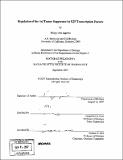Regulation of the Arf tumor suppressor by E2F transcription factors
Author(s)
Iaquinta, Phillip John
DownloadFull printable version (13.57Mb)
Other Contributors
Massachusetts Institute of Technology. Dept. of Biology.
Advisor
Jacqueline A. Lees.
Terms of use
Metadata
Show full item recordAbstract
Effective tumor suppression requires the appropriate function of two major signaling pathways, the pRB-E2F growth-control pathway and the p53 stress-response pathway. Members of the E2F family of transcription factors are key downstream targets of the retinoblastoma protein, pRB, and mediate the activation of genes required for cellular proliferation. The Arf tumor suppressor is a key regulator of p53, and causes activation of p53-mediated cell cycle arrest or apoptosis in the presence of unrestrained proliferation due to cellular oncogenes. E2F has been predicted to be a regulator of Arf, but the exact mechanism of this regulation was unclear. In this study, we investigated the manner in which E2F regulates Arf transcription. We found that Arf is a biologically-relevant target of E2F, but that E2F regulates Arf in a unique manner distinct from its regulation of cell cycle-dependent transcription. In wildtype mouse embryonic fibroblasts, the Arf promoter is specifically repressed by only one E2F isoform, E2F3, and this binding does not fluctuate during cell cycle progression. In response to oncogenic stress, such as expression of the oncoproteins c-Myc or adenovirus E1A, or loss of the tumor suppressors Rb or p53, activating E2F proteins are recruited to Arf and transcription of the gene is induced. In normal mouse tissues Arf is not expressed, yet E2F does not participate in its repression. Arf is only activated in response to the uncontrolled proliferation characteristic of tumor cells, and this correlates with binding of activating E2F proteins to the Arf promoter in tumor tissue in vivo. Importantly, E2Fs are engaged in numerous tumor types, regardless of the initiating oncogenic lesion. (cont.) Finally, we propose that E2F regulation of Arf is a model for its control of a larger class of pro-apoptotic genes. The Arf-p53 pathway is critical for preventing tumor initiation by responding to oncogenic mutation events. We have identified E2F as a key component of this tumor surveillance pathway, which activates Arf in response to inappropriate proliferation regardless of the causative tumorigenic lesion.
Description
Thesis (Ph. D.)--Massachusetts Institute of Technology, Dept. of Biology, 2007. Vita. Includes bibliographical references.
Date issued
2007Department
Massachusetts Institute of Technology. Department of BiologyPublisher
Massachusetts Institute of Technology
Keywords
Biology.